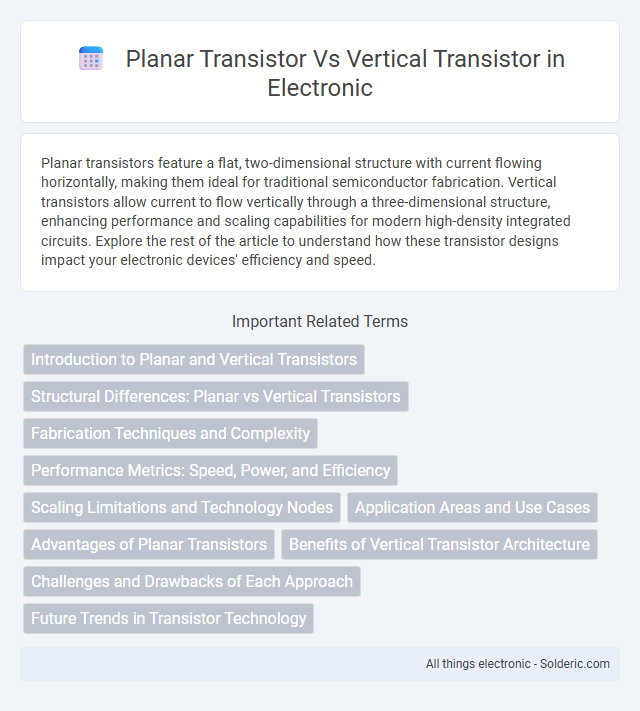Planar transistors feature a flat, two-dimensional structure with current flowing horizontally, making them ideal for traditional semiconductor fabrication. Vertical transistors allow current to flow vertically through a three-dimensional structure, enhancing performance and scaling capabilities for modern high-density integrated circuits. Explore the rest of the article to understand how these transistor designs impact your electronic devices' efficiency and speed.
Comparison Table
| Feature | Planar Transistor | Vertical Transistor |
|---|---|---|
| Structure | Horizontal channel layout on the wafer surface | Vertical channel extending into the substrate |
| Current Flow | Parallel to the wafer surface | Perpendicular to the wafer surface |
| Density | Lower packing density | Higher packing density |
| Short Channel Effect | More pronounced in deep submicron nodes | Reduced short channel effects due to vertical stacking |
| Manufacturing Complexity | Less complex, mature processes | More complex fabrication, advanced etching required |
| Performance | Limited by 2D layout and scaling | Improved drive current and switching speed |
| Applications | Standard CMOS technology, legacy devices | High-density logic, DRAM, 3D integration |
Introduction to Planar and Vertical Transistors
Planar transistors are a type of semiconductor device where the current flows parallel to the silicon wafer surface, widely used in traditional integrated circuits and known for their ease of fabrication and scalability. Vertical transistors, in contrast, allow current flow perpendicular to the wafer surface, enabling higher drive currents and better performance in high-density and power applications. Your choice between planar and vertical transistor technology impacts device efficiency, integration density, and electrical characteristics in modern electronics.
Structural Differences: Planar vs Vertical Transistors
Planar transistors feature a horizontal layout where the current flows parallel to the semiconductor surface, while vertical transistors have a three-dimensional structure allowing current to flow perpendicularly through the device. Vertical transistors offer higher current density and better scalability due to their compact design, making them ideal for advanced technology nodes. Understanding these structural differences can help you choose the right transistor type to optimize performance and integration in your electronic circuits.
Fabrication Techniques and Complexity
Planar transistors are fabricated using well-established lithography and doping processes on a flat silicon surface, making their manufacturing relatively simpler and more cost-effective. Vertical transistors require advanced 3D structuring techniques such as deep etching and epitaxial growth, increasing fabrication complexity and precision demands. The intricacy of vertical transistor fabrication enables higher device density but involves more challenging process control compared to planar designs.
Performance Metrics: Speed, Power, and Efficiency
Planar transistors exhibit lower electron mobility compared to vertical transistors, resulting in slower switching speeds and reduced overall performance. Vertical transistors, such as FinFETs, offer improved speed due to better channel control and reduced short-channel effects, leading to enhanced power efficiency and lower leakage currents. Your device's performance and power consumption can significantly benefit from choosing vertical transistor architectures, especially in high-speed and energy-sensitive applications.
Scaling Limitations and Technology Nodes
Planar transistors face significant scaling limitations as channel length shrinks below 10 nanometers, causing short-channel effects and leakage currents that degrade performance. Vertical transistors, such as gate-all-around (GAA) structures, overcome these challenges by enabling better electrostatic control and allowing technology nodes to progress beyond 5 nanometers. Your choice between planar and vertical transistor architectures impacts device efficiency and scaling potential in advanced semiconductor manufacturing.
Application Areas and Use Cases
Planar transistors are widely used in general-purpose integrated circuits including microprocessors and memory chips due to their mature manufacturing technology and cost-effectiveness. Vertical transistors, such as FinFETs, dominate high-performance and low-power applications in advanced processors and mobile devices, benefiting from superior control of short-channel effects and enhanced scalability. Emerging applications in artificial intelligence and 5G technology increasingly rely on vertical transistor architectures to achieve higher speed and energy efficiency.
Advantages of Planar Transistors
Planar transistors offer superior ease of fabrication and integration into existing semiconductor manufacturing processes, resulting in cost-effective mass production. Their simple two-dimensional structure enables better control of channel dimensions, improving device reliability and uniformity across wafers. Planar transistors also demonstrate lower variability and leakage currents compared to vertical transistors, enhancing overall circuit performance and power efficiency.
Benefits of Vertical Transistor Architecture
Vertical transistor architecture offers significant benefits in scaling down semiconductor devices by enabling a smaller footprint and higher transistor density compared to traditional planar transistors. This three-dimensional structure enhances current drive capabilities and reduces short-channel effects, leading to improved performance and power efficiency in modern integrated circuits. The vertical orientation also facilitates better heat dissipation and allows for enhanced electrostatic control, which is crucial for advanced technologies such as FinFET and Gate-All-Around transistors.
Challenges and Drawbacks of Each Approach
Planar transistors face limitations in scaling due to short-channel effects and increased leakage currents as device dimensions shrink, impacting their performance and power efficiency. Vertical transistors, while enabling higher integration density and improved drive current, encounter challenges in fabrication complexity and thermal management due to their three-dimensional structure. Both approaches require advanced manufacturing techniques to address these issues and optimize device reliability in modern semiconductor applications.
Future Trends in Transistor Technology
Future trends in transistor technology emphasize the shift from traditional planar transistors to vertical transistors, such as FinFETs and gate-all-around (GAA) structures, enhancing device scalability and performance. Vertical transistors offer superior electrostatic control and reduced short-channel effects, enabling continued miniaturization for advanced semiconductor nodes below 3 nm. Integration of vertical architectures facilitates higher drive currents and lower power consumption, driving innovations in AI processors, 5G devices, and high-performance computing.
Planar transistor vs Vertical transistor Infographic

 solderic.com
solderic.com